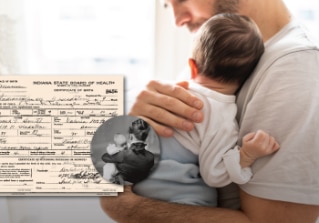Ancestry® Family History
Birth Certificates: a Cornerstone for Family History Research
Birth certificates are familiar to most people. Many use them as proof of identity to obtain state ID cards, driver’s licenses, passports, and more. But for family history, birth certificates and other civil birth registration records can help you not only find birth event information but also other clues that can help you with your research.
Vital Statistics in the U.S.

Civil registration of births and deaths began because governments wanted insights into mortality rates, health, and diseases in their populations. Some countries began civil registration of births, marriages, and deaths in the 1800s (and in some cases even earlier). But in the U.S., across-the-board civil registration of vital records is a relatively new thing. Many states did not put in place laws requiring civil registration until the late 19th and early 20th centuries. And even then, there was not always complete compliance.
Although records eventually began to be compiled on the state level, registrations may have initially taken place on a county level. In the case of New England, birth and death registrations began on the town level and were sometimes later shared with the state. The beginning of statewide civil registrations varied from state to state because there was no nationally coordinated rollout of vital record registrations.
What Can You Learn from Birth Records
Although the information provided on a birth record can vary according to where and when the birth was recorded, birth certificate records can include your family member’s name, date and place of birth—and possibly their parents' names and the states where they were born.
Some birth certificates, such as those found in the Ancestry collection of Indiana, Birth Certificates from 1907-1940, can include the family address, both parents’ names (including the mother’s maiden name) and their residence(s), along with their ages, the states where they were born, and their occupations. This collection of birth certificates also asked how many children the mother had including the birth being recorded, and how many of those children were living.
As shown in this example, recent birth records can include a lot of valuable information. Earlier records, on the other hand, may be a bit more sparse on details. But any birth record is worth seeking out for the clues it can provide.
Tips for Finding Birth Records
Here are some tips for finding birth records on Ancestry.
Add additional information to narrow down searches. If you’re looking for a common name, try adding the names of the mother and father to help focus your search.
Seek out the birth records for all family members. If you find the birth records of your ancestor’s siblings, you might find helpful details that weren’t included on your ancestor’s birth record.
Consult other record collections. To help you estimate dates of birth and narrow your search, look in census records for ages and places of birth.
Request the original record. An index is a very simple overview of an actual record. So when you find a record in a birth index, it’s a good idea to request a copy of the original birth certificate. You can find out where the original records are held by looking at the source information and description in the Ancestry record collection page.
Make New Discoveries with Birth Records
Birth certificates are one of the cornerstones of family history research. Together with other vital records, they can help paint a rich picture of your family story. Start making new discoveries about your past with a search of Birth, Marriage, and Death records on Ancestry today.